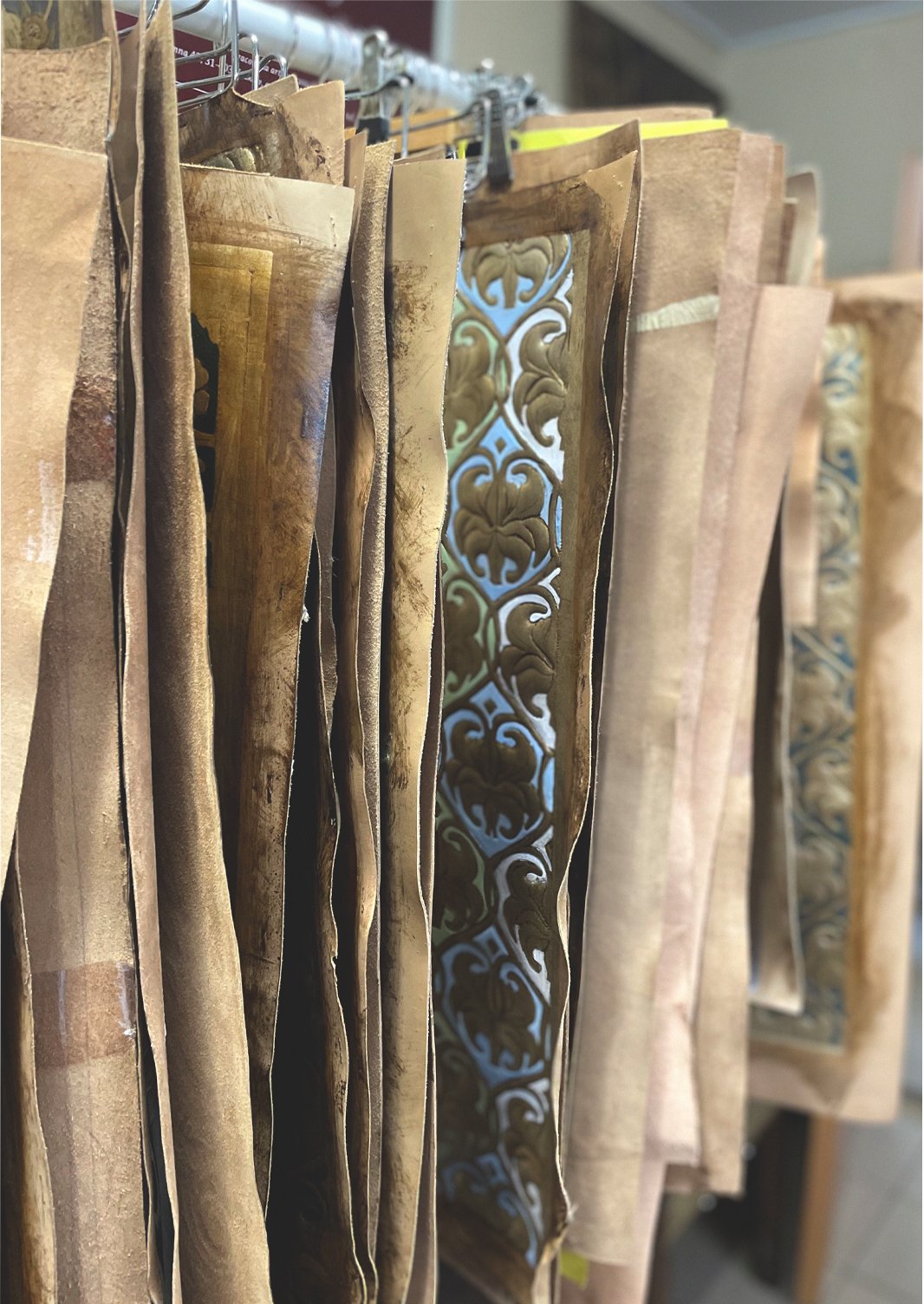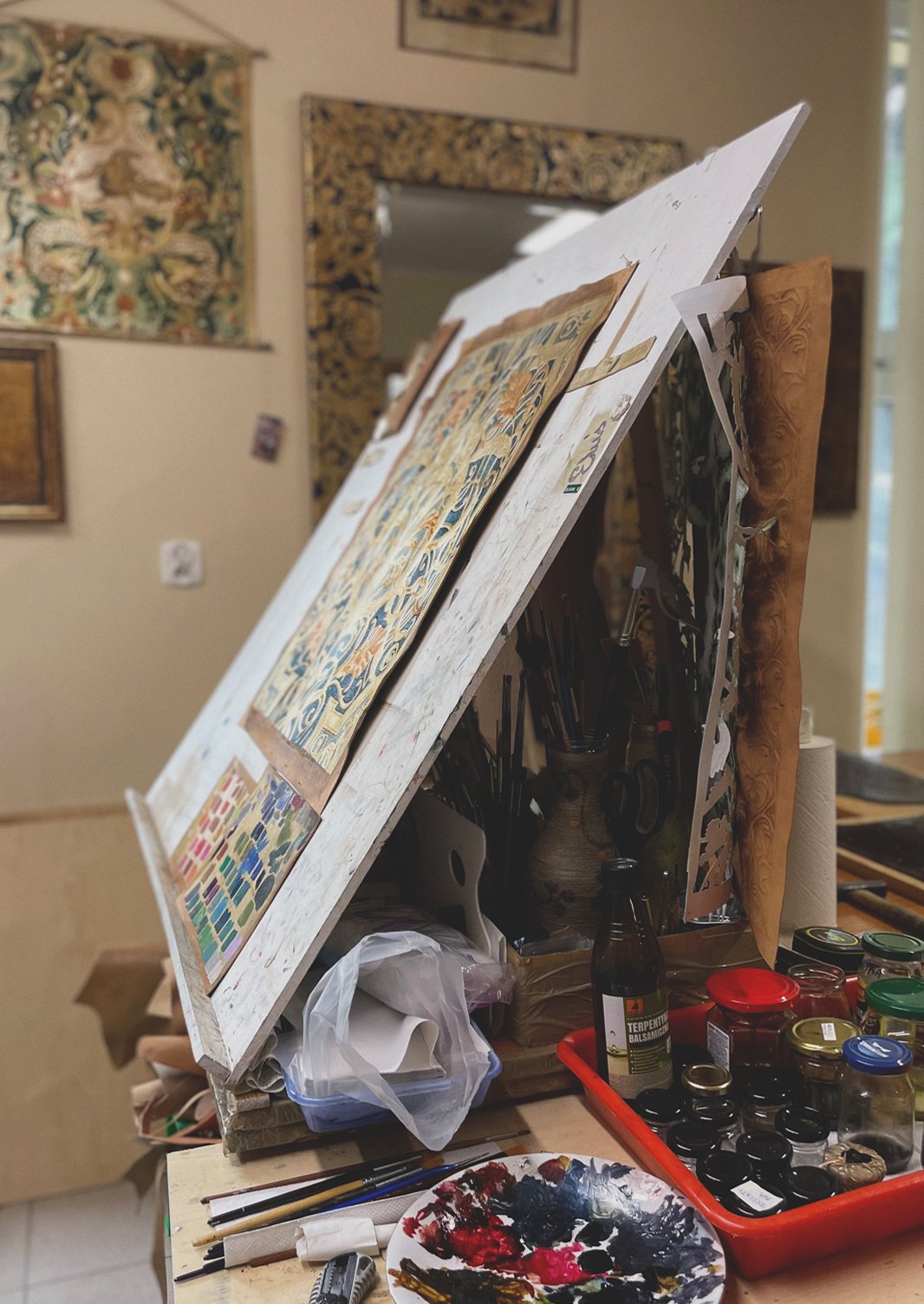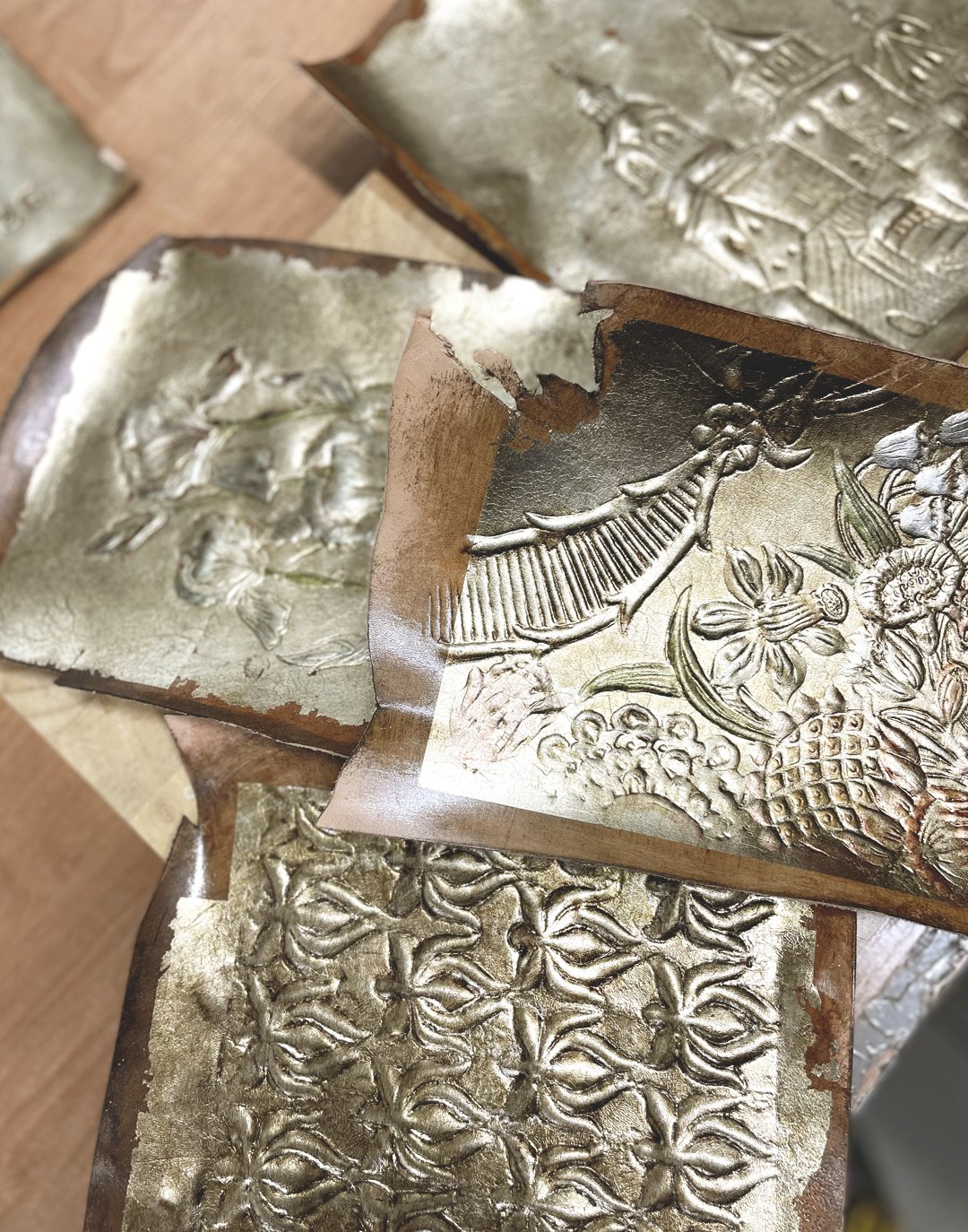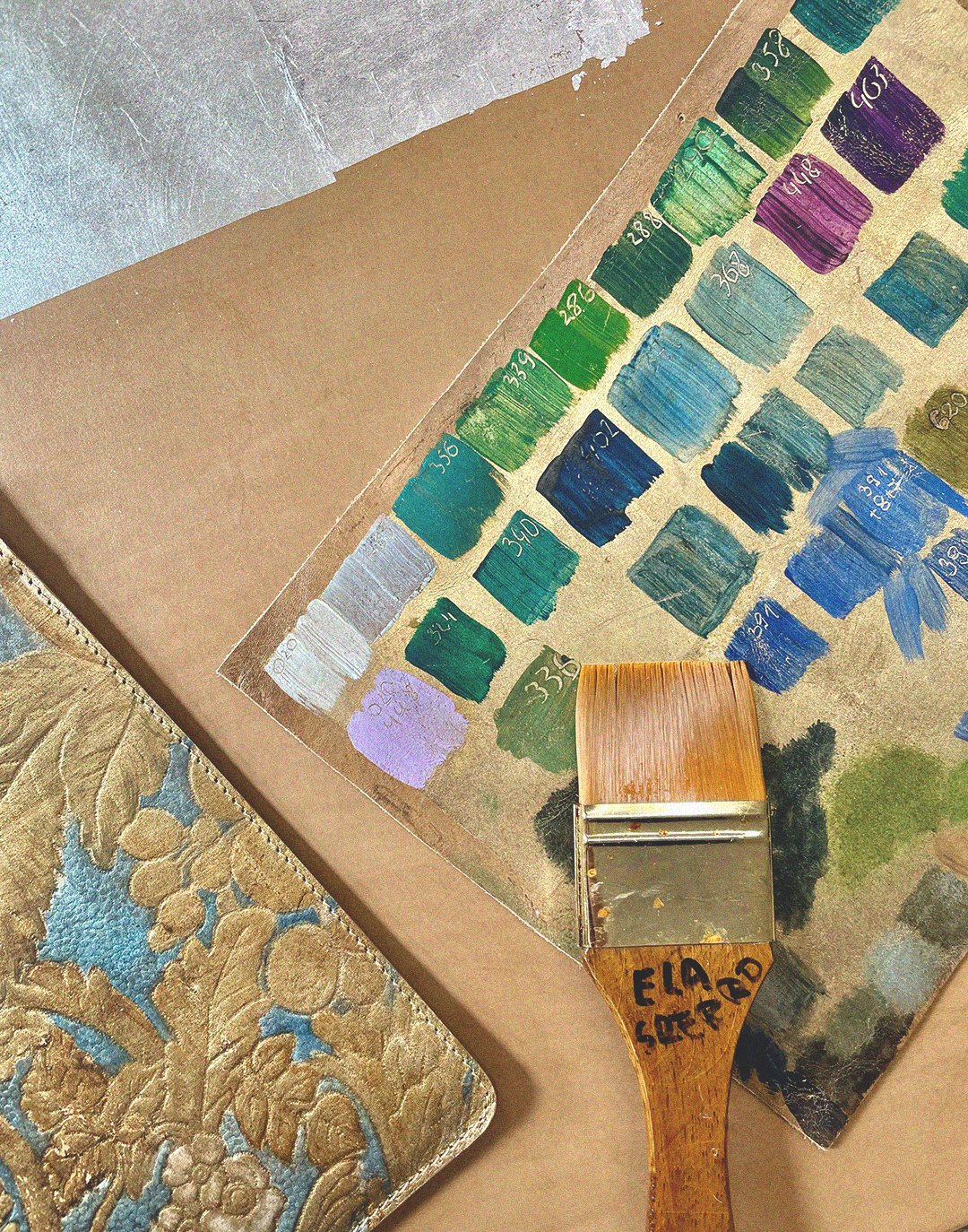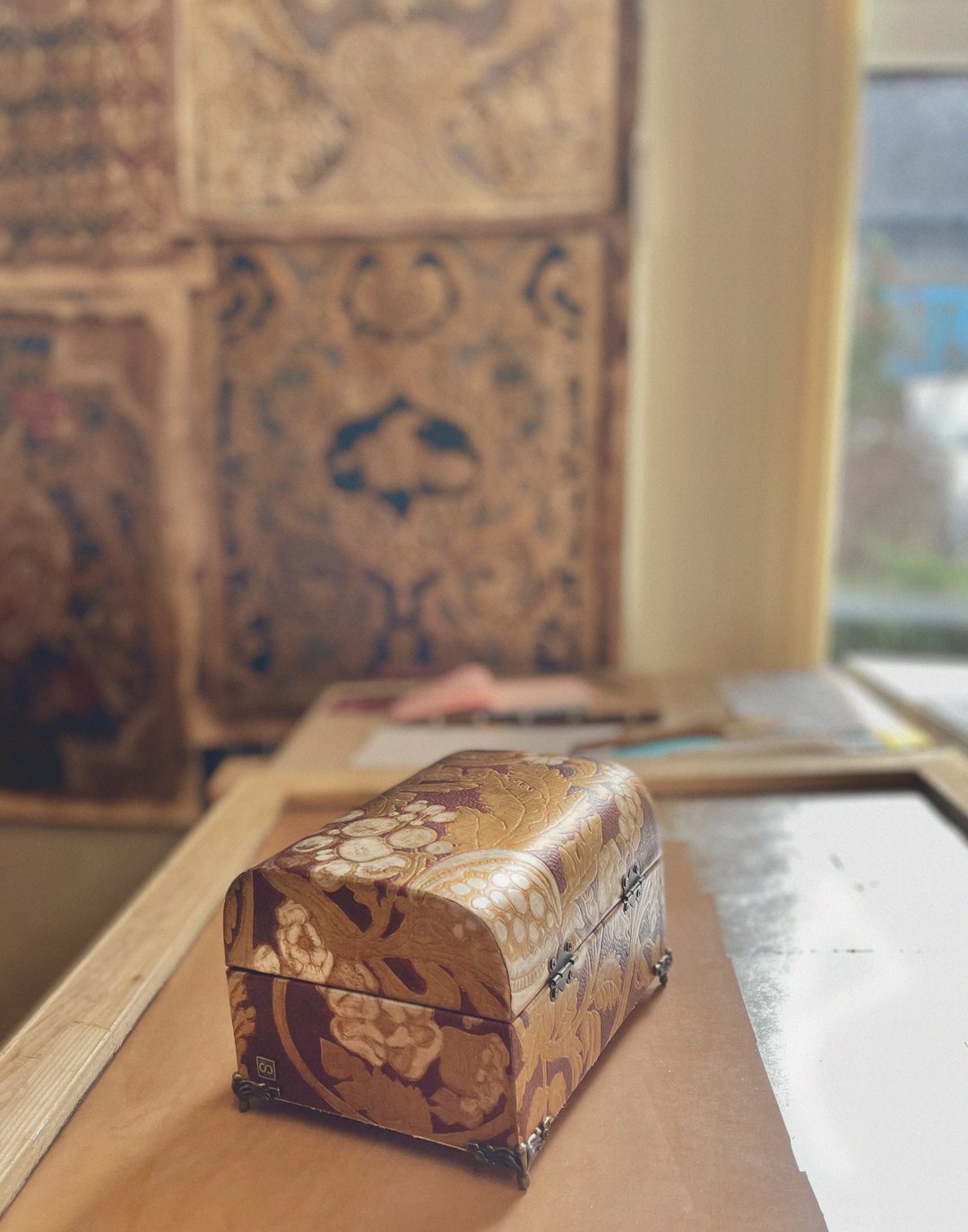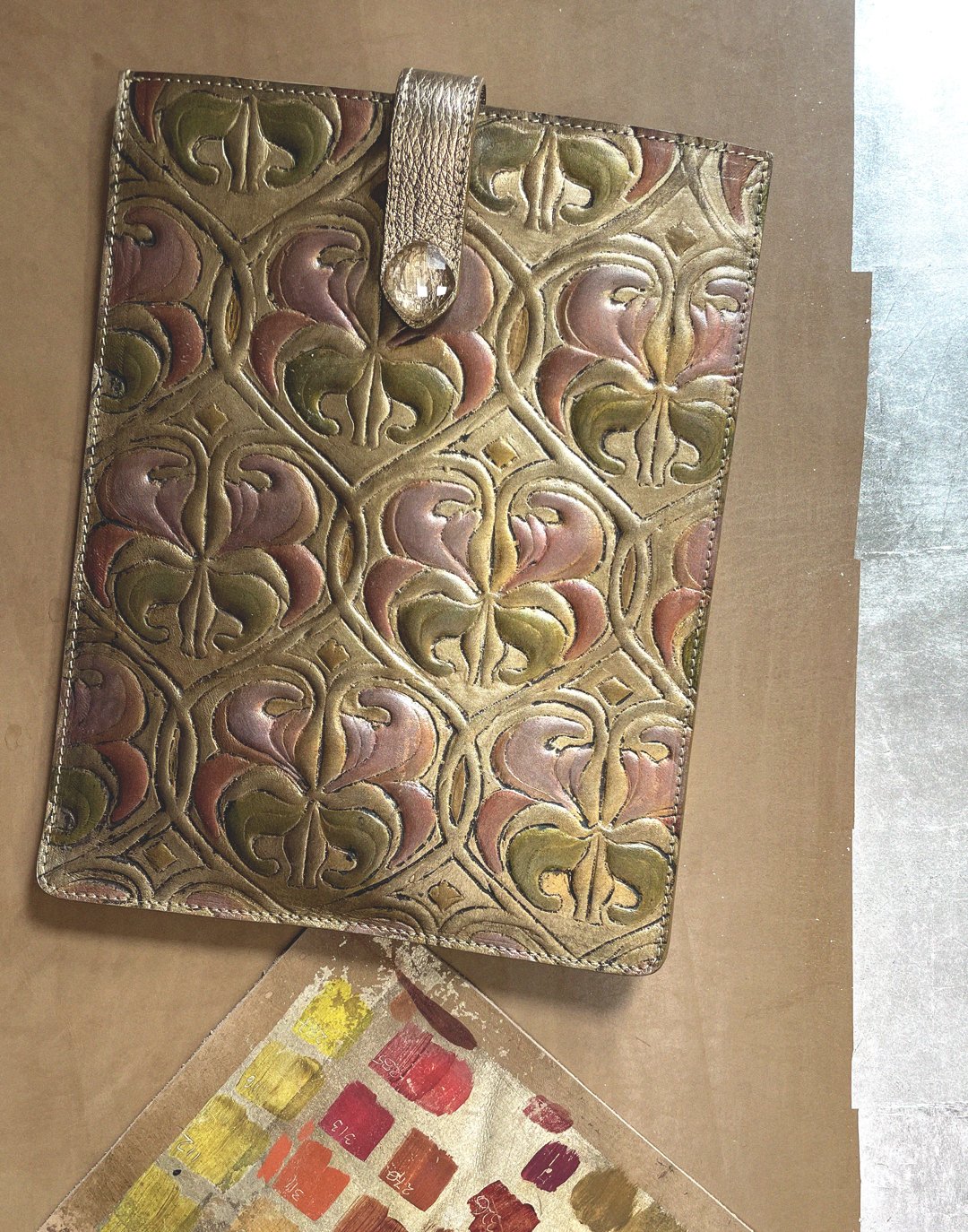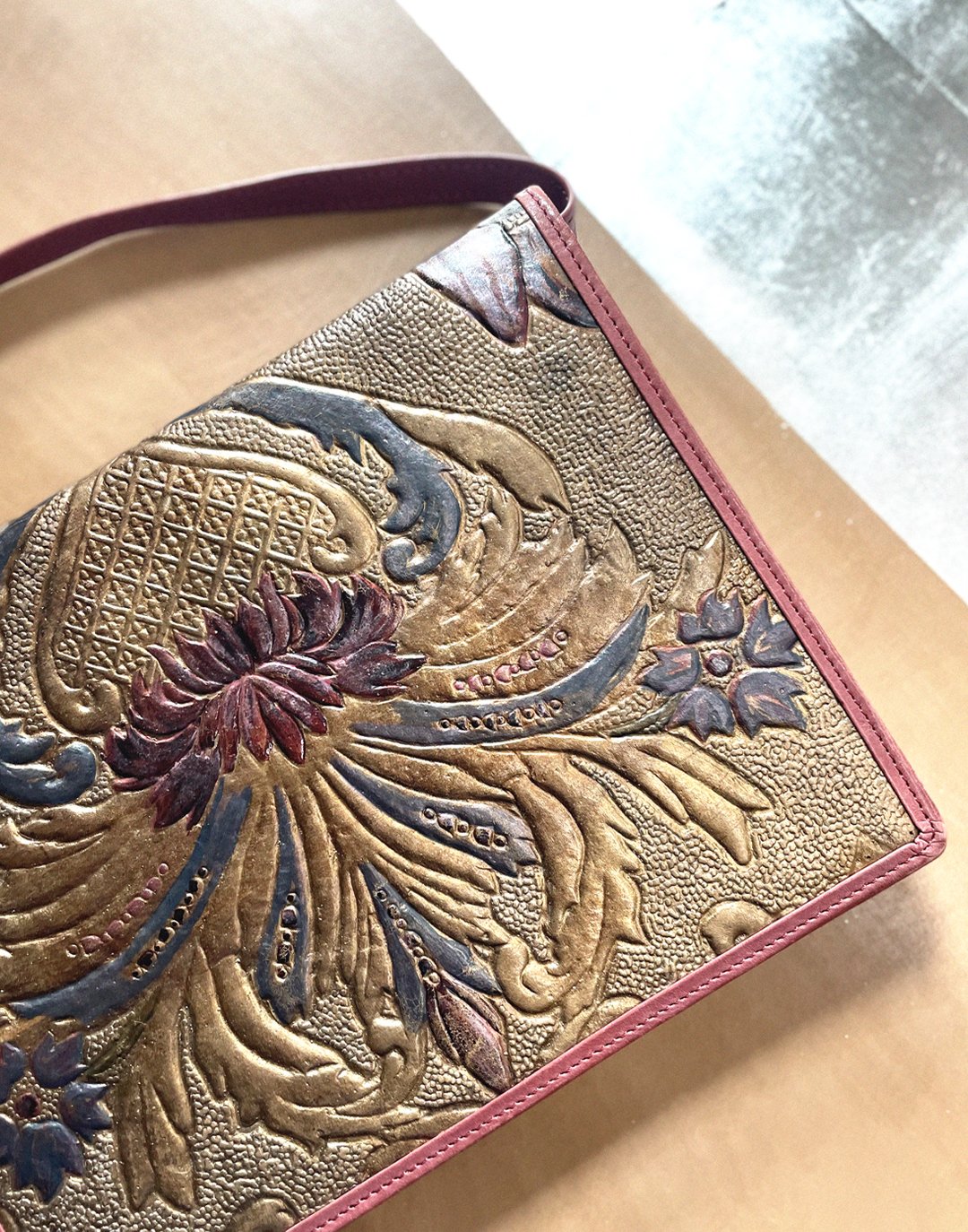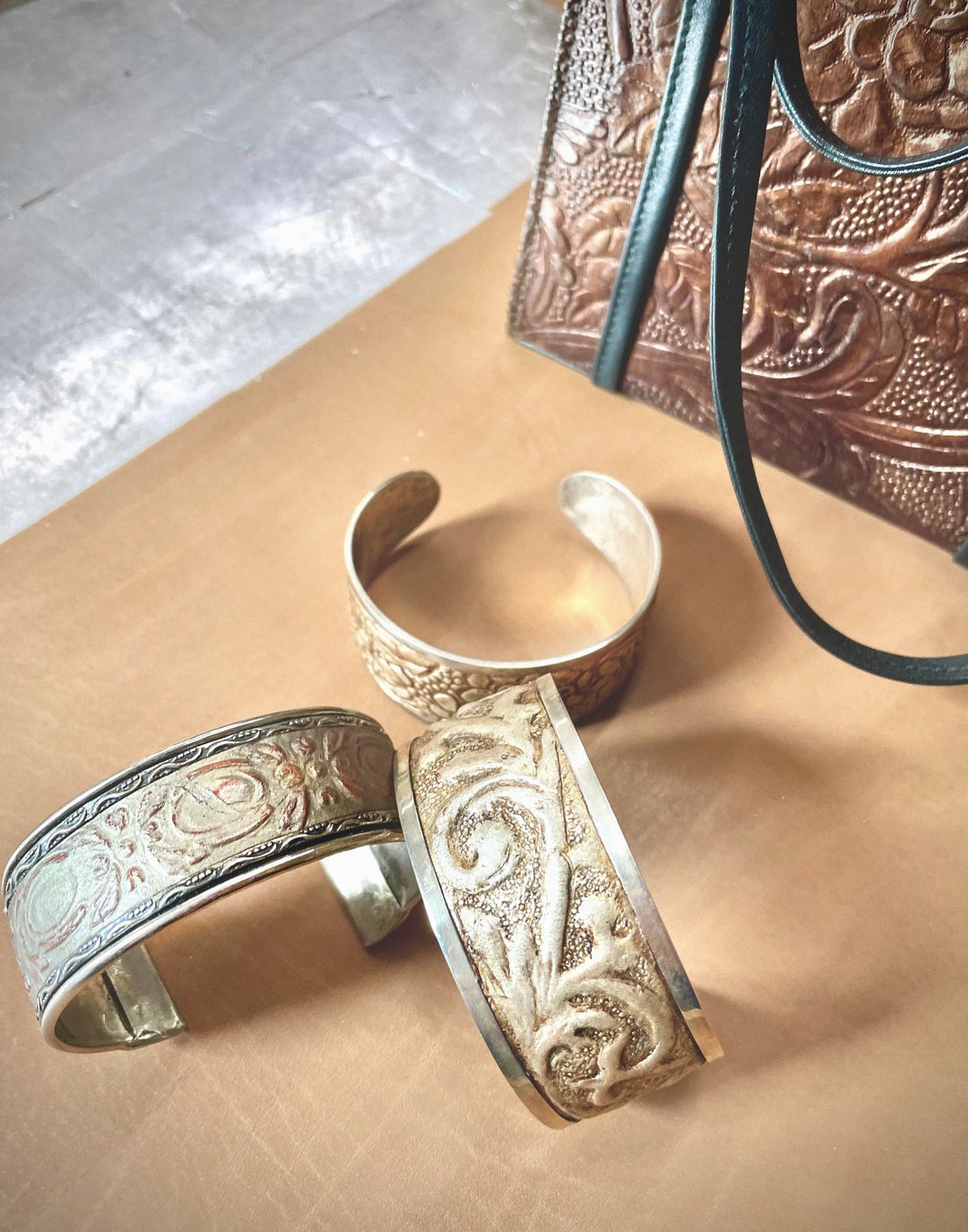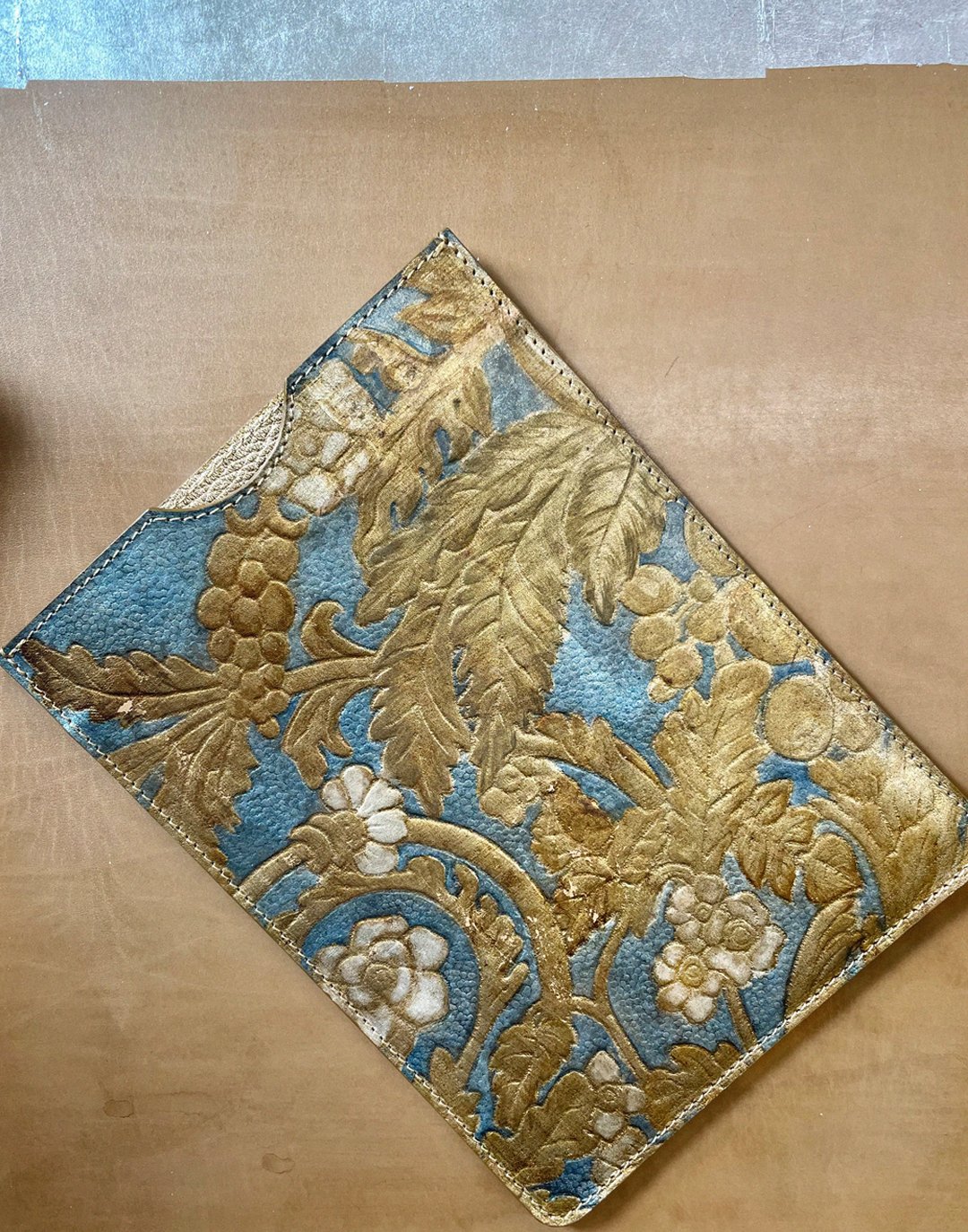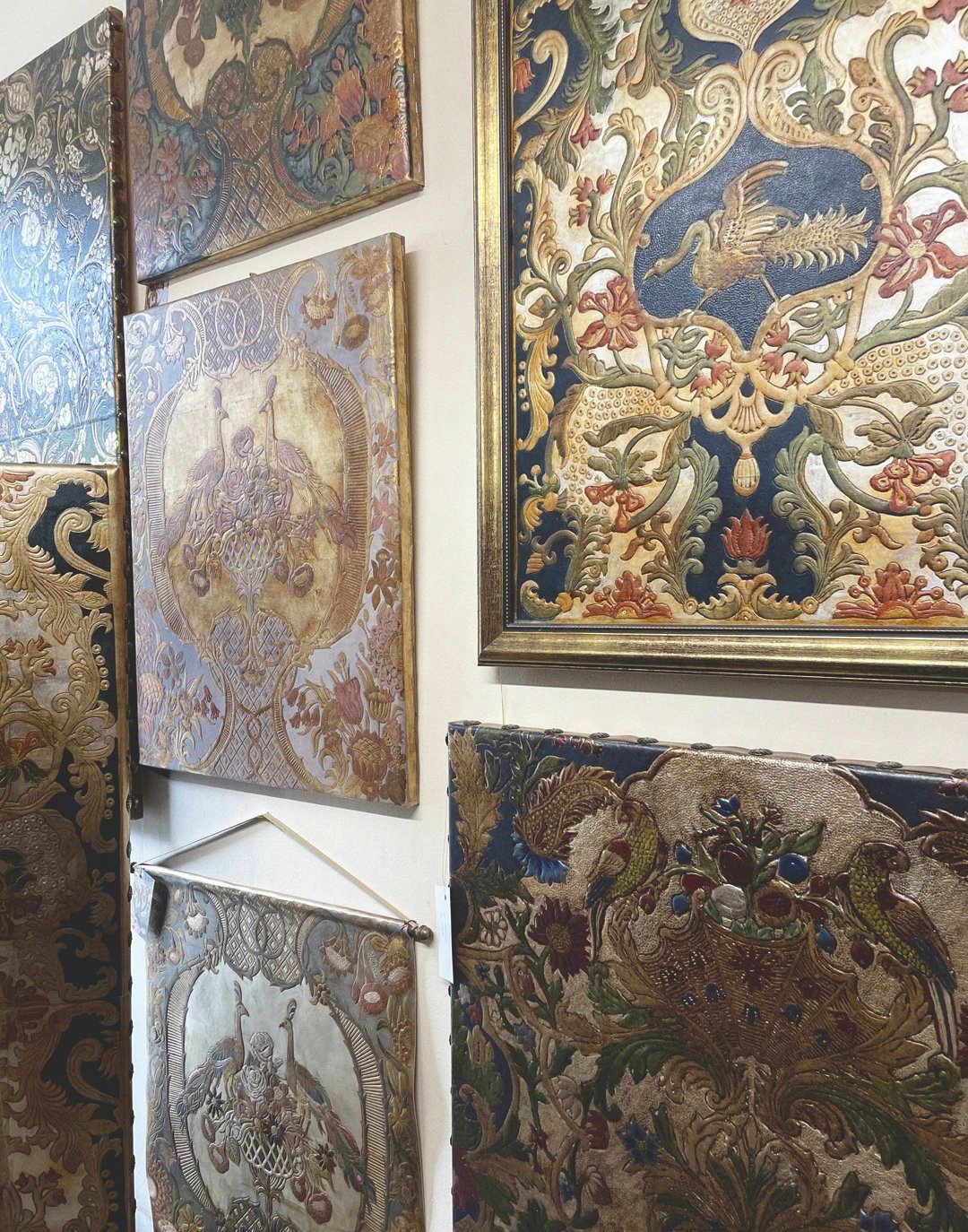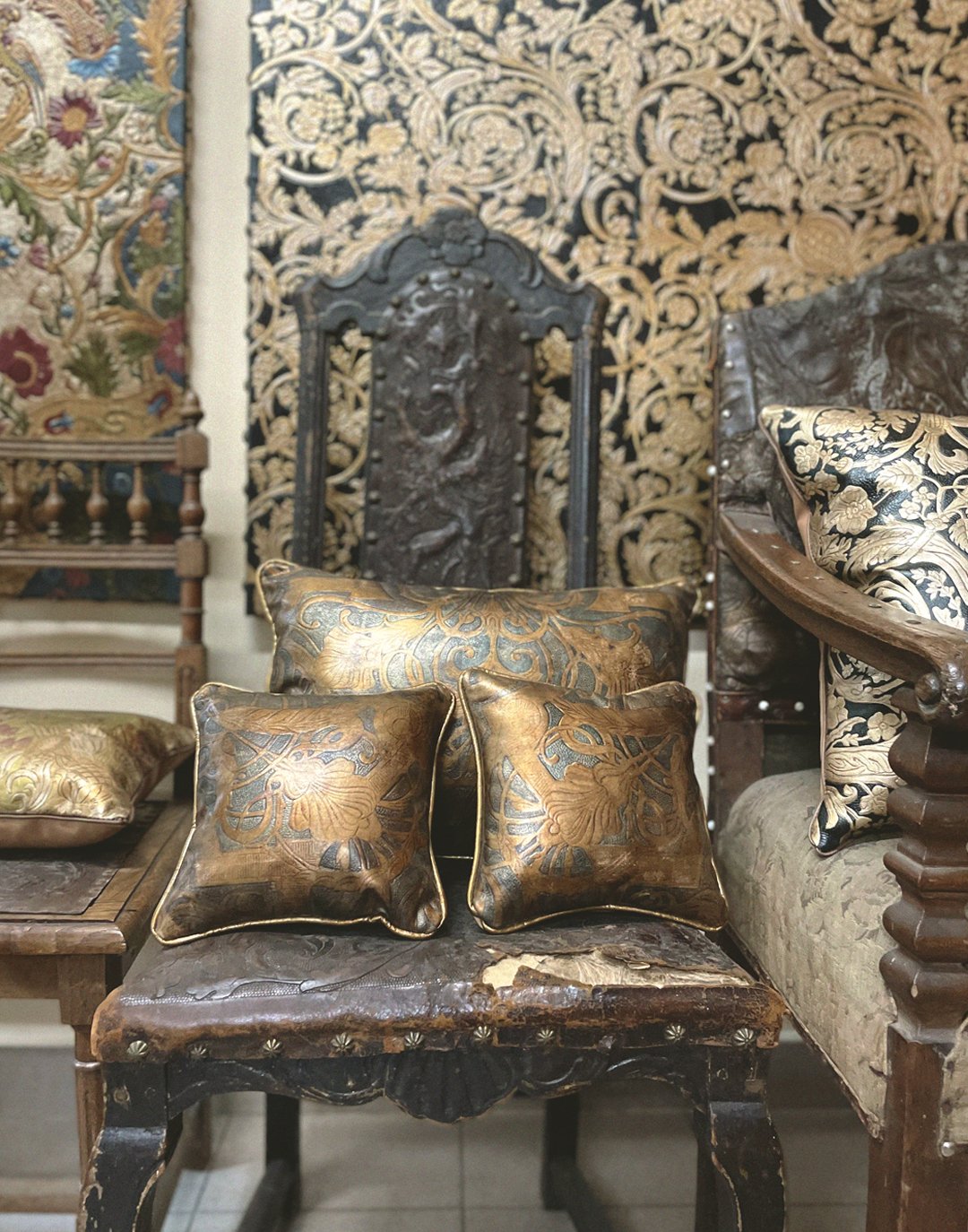Consiste
Consiste, a family workshop cultivating the centuries-old gilt leather technique
Consiste - gilt leather workshop in Cracow, photo courtesy of A.Kosakowska
This superb technique of elaborate artistic leather treatment was once highly coveted among the elites. It graced the walls of wealthy houses, palaces, sacral interiors, and adorned dressy attires.
The name “gilt leather” – in German Goldleder, in Italian cuoi dorato, in Polish kurdyban – can give quite a misleading impression, amplifying the involvement of gold. Shakespeare’s phrase from The Merchant of Venice, “All that glisters is not gold”, is very accurate here. Gilt leather does not incorporate flakes of gold, but rather flakes of silver. It is after the application of a special lacquer (known as varnish) that the silver mimics a lustrous gold effect to perfection.
Its genesis dates back to the late Middle Ages. Originating in North Africa, it owes its spread to Europe via Spain to the Moors. Hence, the Polish name kurdyban – a nod to the city of Cordoba, which was the first European centre to develop gilt leather workshops. From there, the craft was adapted and cultivated by master craftspeople in centres like Mechelen, Amsterdam and Venice; a small group of workshops operated around St Paul’s in London, too. Meanwhile, Poland never developed its own gilt leather production, but its beautiful pieces found their way to the country through the wedding dowry of Queen Bona Sforza in the 16th century. Even though gilt leather can be seen hanging in prominent locations all over Europe, it is an often overlooked part of European heritage, with its position assigned to museums rather than practised art.
Today, however, Kraków is home to Consiste. It is one of very few active workshops in Europe keeping the craft alive and producing new pieces – and the only one in Poland. The workshop is a family business run by sisters Ewa and Aga, of graphic design and conservation backgrounds respectively. They inherited their skills and passion from their parents, both art conservators with over 30 years of experience within this remarkable craft.
“For us, gilt leather production is a mission rather than something we do for profit,” says Ewa. “Our parents started looking into methods of conservation for the material in the 1990s. They developed a technology of producing gilt leather and passed it on to us. The conservation of gilt leather is not uncommon, but the production of new pieces is very rare.”
Edward Kosakowski, was involved in the conservation of the Venetian gilt leathers that adorn the walls and furniture in the collection of the Wawel Royal Castle in Kraków. Conservation of one piece of furniture from this collection was, in turn, the very first gilt leather assignment of his daughter Aga. “It was a special project for our father and it started our family tradition. Also, my first ever conservation assignment was a piece of furniture that is now on display in the Wawel castle,” says Aga.
Their first gilt leather piece created from scratch owes its existence to the mother of the family, Krystyna. It is a family joke that she should be known as “the mother of varnish”. Through a lengthy process of trial and error, she figured out the traditional recipe for this special lacquer. It is the most important element of the production process – and the family’s best-protected secret. “It is a very tricky composition to get right, its success is subject to many conditions, including the weather. Yet is is the essential element that makes it a gilt leather,” says Aga.
Back in the day, gilt leather workshops involved the cooperation of tanners, goldsmiths working with leather, and painters. At Consiste, everyone has their own area of specialism, too – they work together like a small guild. Their shared conservation background makes them united in their passion and respect for all things old and forgotten, as well as their ambition to discover it anew.
A gilt leather piece visually resembles a type of painting on leather. However, the order of working is inverted when compared to traditional painting. Instead of covering the paint and glazing it as the final layer, the varnish is actually applied at the start. Some designs are realised without colouring, in order to enhance the shimmering golden palette. As the material ages, time paints its own patterns. The colour gets gradually darker, adding a mysterious and noble character to the piece.
The production of a gilt piece is a labour-intensive process with several stages. It requires exceptional precision, time and expertise. “Through studying books, we were able to recreate the process of production from the 16th century. We are using the same means and techniques as back then, trying to be as faithful to the past as possible,” explains Ewa, one of the two sisters running Consiste. “We use leather from a Polish tannery, though we are looking into eco-leather options to incorporate into our range in the near future. The leather has to be non-impregnated, tanned with vegetable agents. The first step is sticking silver flakes on the surface of the skin. To protect the silver against corrosion, we apply egg whites, as it was done traditionally, centuries ago,” Ewa continues. “Next, the leather is stamped or punched, either manually or using a special press developed by our father.”
The following stage is varnishing. Varnish sets fast, hence it has to be done very quickly and carefully. On bigger pieces, it often requires a team effort. “Once the varnish is dry, it is time to paint. This takes a long time, as the varnish has to be perfectly dry before applying any paint. Then the leather needs to dry for even longer after painting,” explains Aga. “For instance, creating a bag or small leather accessory takes eight months, after which the painted piece has to be left to dry for an additional year.”
Consiste cooperates with the best local makers on gilt leather bags and small leather accessories. The long waiting time only adds to its value. Each piece takes time to manufacture, but is also designed to last and age gracefully with its owner. “Those bags are our mother’s and are over 20 years old. We can create replicas of them, as well as come up with new designs to match the client’s specific taste,” says Aga. A recent add-on to their accessory range is silver jewellery incorporating gilt leather details.
Wall decoration is the most popular use of the technique. Beautiful gilt leather panels can cover entire walls, as well as hang, framed, like a painting. The Consiste artists curiously look for new applications of this traditional material. “We are open to experiments with form, design and colour. We want to show that this historical technique is still valid and suits both historical and contemporary styles and interiors,” says Ewa. While in past centuries, the majority of pieces were decorated with battle or genre scenes, new gilt leather commissions can include abstract motifs and reflect modern times.
Aga and Ewa visit craft centres like Venice and Cordoba for research and inspiration; they enjoy exchanging knowledge and skills with gilt leather enthusiasts internationally. “We are in regular contact with a Norwegian gilt leather guild. It is an association of people practicing the craft as a hobby. We connect with each other, organising workshops together here in our studio. It is also inspiring to see their input in popularising and sharing knowledge about the craft.” Consiste encourages all interested individuals to attend gilt leather workshops in their studio. It is a unique chance to familiarise oneself with its historical underpinnings and create an individual gilt leather sample.
Italy used to be an important centre for gilt leather, as far back as the 15th century. Nowadays, however, there are no active workshops. Consiste is currently preparing to set up a new showroom in Tuscany. They hope to establish new clients and artistic collaborations in a place where the craft used to flourish so well, and with the close proximity of luxury houses and workshops.
Visit Consiste’s website to see their full range of products and services offered.
P.S. If you’re in Kraków, you can admire beautiful interior works created by Consiste not only in the Wawel Royal Castle, but also in the renowned Wierzynek restaurant by the main market square. The project was realised in 2015 and encompasses over 150 wall panels featuring exclusive paradise bird motifs designed uniquely for the restaurant.

